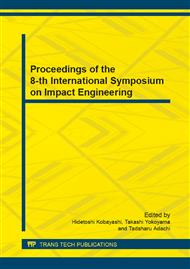p.586
p.593
p.599
p.605
p.611
p.617
p.623
p.629
p.637
Study on Impact Collapse Characteristics of CFRP Double-Hat Members According to Stacking Angle
Abstract:
There has been greater demand on fuel mileage improvement and reduced CO2 emission in automobile without sacrificing safety. To meet these requirements, light weight car body is widely adopted. In addition, advanced country already started the strict regulation on fuel mileage and exhaust gas emission because of energy depletion by automobile and severe environmental contamination. Especially, during the initial stage of car design, side member of front side that absorbs significant amount of energy should be precisely evaluated for collapsing and energy absorption prior to estimate safety performance on frontal collision of car. Therefore, CFRP double hat and hat-shaped member were prepared to supplement the issues of splitting between “ᄃ” shaped member and planar one. According to stacking configuration, energy absorption characteristics via impact collapsing experiment were evaluated to acquire CFRP double-hat shaped member.
Info:
Periodical:
Pages:
623-628
Citation:
Online since:
June 2014
Authors:
Keywords:
Price:
Сopyright:
© 2014 Trans Tech Publications Ltd. All Rights Reserved
Share:
Citation:


